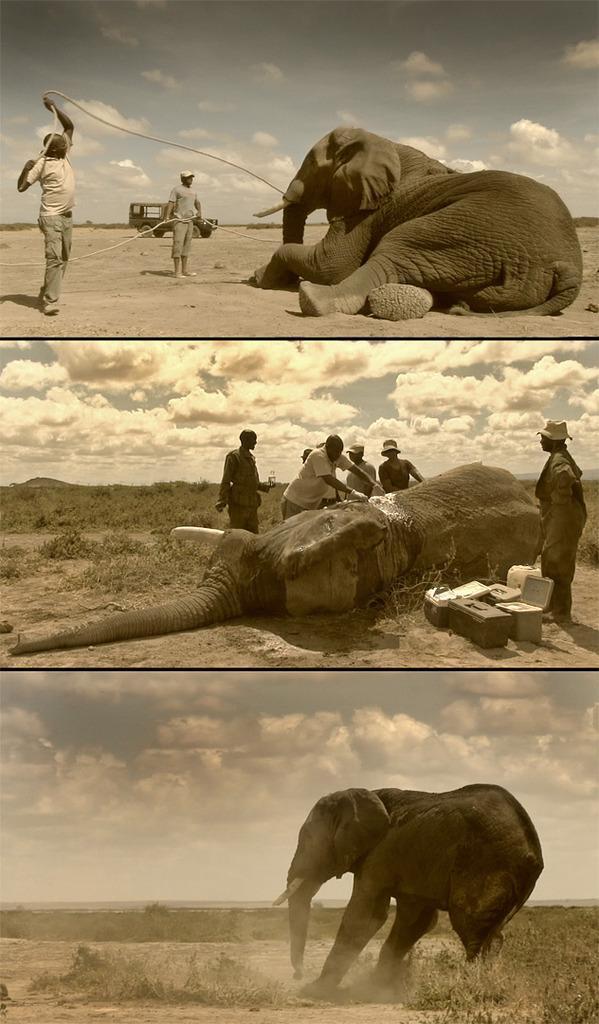
by Nick Brandt
October 19
Two weeks ago, Emo, a 32 year old big bull elephant, was speared FIVE times, somewhere near the south side of the Amboseli National Park boundary. He somehow survived.
The Amboseli Trust for Elephants team found Emo walking in the bush a week ago, before he disappeared again. A couple of days ago, we saw him, walking around the Park, with pus dripping copiously from multiple spear wounds - in his side, in his ear, even in his groin. In the case of two of the spear wounds, it had passed straight through and out again.
We called the Amboseli Trust for Elephants, and Richard Bonham, both of whom called KWS’s vet in Tsavo National Park, Dr. Poghorn, whose operations are financed by the David Sheldrick Wildlife Trust. They told him to come as soon as he could. Given their severity and the level of infection, there is no way that Emo would survive without treatment.
Unfortunately, Dr Poghorn has an insanely large area to cover - from Tsavo across to Amboseli and the Chyulu Hills and all the way to the coast. One man in one car covering literally tens of millions of acres. Currently, with typically as many as three cases requiring his attention a day in Tsavo, it can take time for him to see an opening to make the 3-4 hour drive over to Amboseli.
In the meantime, everyone kept a watch on Emo while we awaited Dr. Poghorn’s arrival.
Looking closely at Emo’s spear wounds - he had been speared from both above and below - it seemed likely that this was a pre-meditated attack on Emo, not remotely motivated by him raiding crops or charging anyone. This was done by five men, with five spears, on a mission.
Yesterday morning, Dr. Poghorn arrived and set to work. First, he darted Emo. Within ten minutes, Emo’s legs caved from underneath him, and he fell into a sedated sitting position. Dr. Poghorn lassoed Emo and turned Emo over onto his side to be able to work on his wounds. He injected more anesthetic into the veins in his ear, and got to work.
It was distressing to watch, as he reached deep into Emo’s side, up to his elbow, to pull out all the pus. Huge amounts of hydrogen peroxide and iodine were poured in, and liquid antibiotic swabbed deep within. A steady supply of water was poured over Emo’s head and ears to keep him cool. A small stick propped open the end of his trunk to help his breathing. Katito and Robert from Amboseli Trust for Elephants provided excellent assistance throughout.
After about 30 minutes work, Dr. Poghorn was done. He gave Emo another shot. Within seconds, Emo woke up, and staggered unsteadily to his feet. But he recovered amazingly quickly, walking off in the direction of the marsh, no doubt wondering what the hell had happened to him.
Dr. Poghorn is reasonably confident that Emo will survive if his wounds are not re-infected. All being well, he will return to Amboseli in a month to give Emo another round of antibiotic shots. This is a testament to the strength of an elephant, given the severity of the wounds.
In the meantime, we will try to keep a watchful eye on him. Typically, the elephants know they are safe within the Park boundary. This is why so often, elephants that have been speared or shot and survived are seen making their towards the (at only 100,000 acres, very small) park.
The treatment for Emo is testament to the importance of respective groups working together - Kenya Wildlife Service, Amboseli Trust for Elephants, David Sheldrick Wildlife Trust, and Big Life Foundation.
However, unfortunately, these spearings are not going to stop any time soon. This is complete conjecture, but we feel that a couple of recent spearings may have occurred as a left-over from the aggravated feelings between the Maasai and Kenya Wildlife Service over the share of Park tourism revenue in July. The result was a massacre of a number of elephants, lions and buffalo - innocent pawns caught in a power struggle - by Maasai warriors. Those events, we think, has left some Maasai warriors still feeling empowered, their blood up, by the complete lack of punishment for their actions by KWS.
The Big Life teams will continue to work closely with the local communities, continuing to prevent killings and arrest poachers. The hopes are that KWS and the Maasai communities will resolve their differences and work towards a mutually beneficial future for humans and animals alike. And hopefully, someone will provide the funding for another vet exclusive to this area. Right now, with this escalation in poaching, there are just three Kenya Wildlife Service vets in all of Kenya not including Nairobi - Dr Poghorn in the south east of the country, another vet in the South West (Masai Mara), and the third up north (Laikipia).
The Big Life teams will continue to work closely with the local communities, continuing to prevent killings and arrest poachers. The hopes are that KWS and the Maasai communities will resolve their differences and work towards a mutually beneficial future for humans and animals alike. And hopefully, someone will provide the funding for another vet exclusive to this area. Right now, with this escalation in poaching, there are just three Kenya Wildlife Service vets in all of Kenya not including Nairobi - Dr Poghorn in the south east of the country, another vet in the South West (Masai Mara), and the third up north (Laikipia).
